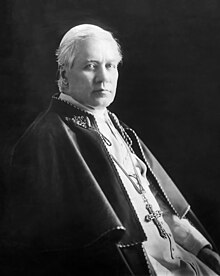
Back Paus Pius X ACE Pous Pius X Afrikaans Pius X. ALS Pío X AN بيوس العاشر Arabic بيوس العاشر ARZ Piyu X Aymara X Piy Azerbaijani Pius X. BAR Пій X Byelorussian
Pius X | |||||||||||||||||||||||||||||||||||||||||||||||||
|---|---|---|---|---|---|---|---|---|---|---|---|---|---|---|---|---|---|---|---|---|---|---|---|---|---|---|---|---|---|---|---|---|---|---|---|---|---|---|---|---|---|---|---|---|---|---|---|---|---|
| Bishop of Rome | |||||||||||||||||||||||||||||||||||||||||||||||||
 Pius X c. 1914 | |||||||||||||||||||||||||||||||||||||||||||||||||
| Church | Catholic Church | ||||||||||||||||||||||||||||||||||||||||||||||||
| Papacy began | 4 August 1903 | ||||||||||||||||||||||||||||||||||||||||||||||||
| Papacy ended | 20 August 1914 | ||||||||||||||||||||||||||||||||||||||||||||||||
| Predecessor | Leo XIII | ||||||||||||||||||||||||||||||||||||||||||||||||
| Successor | Benedict XV | ||||||||||||||||||||||||||||||||||||||||||||||||
| Orders | |||||||||||||||||||||||||||||||||||||||||||||||||
| Ordination | 18 September 1858 by Giovanni Antonio Farina | ||||||||||||||||||||||||||||||||||||||||||||||||
| Consecration | 16 November 1884 by Lucido Maria Parocchi | ||||||||||||||||||||||||||||||||||||||||||||||||
| Created cardinal | 12 June 1893 by Leo XIII | ||||||||||||||||||||||||||||||||||||||||||||||||
| Personal details | |||||||||||||||||||||||||||||||||||||||||||||||||
| Born | Giuseppe Melchiorre Sarto 2 June 1835 | ||||||||||||||||||||||||||||||||||||||||||||||||
| Died | 20 August 1914 (aged 79) Apostolic Palace, Rome, Kingdom of Italy | ||||||||||||||||||||||||||||||||||||||||||||||||
| Previous post(s) |
| ||||||||||||||||||||||||||||||||||||||||||||||||
| Motto | Instaurare Omnia in Christo[1] (To restore all things in Christ) | ||||||||||||||||||||||||||||||||||||||||||||||||
| Signature | |||||||||||||||||||||||||||||||||||||||||||||||||
| Coat of arms |  | ||||||||||||||||||||||||||||||||||||||||||||||||
| Sainthood | |||||||||||||||||||||||||||||||||||||||||||||||||
| Feast day | 21 August 3 September (General Roman Calendar 1955–1969) | ||||||||||||||||||||||||||||||||||||||||||||||||
| Venerated in | Catholic Church | ||||||||||||||||||||||||||||||||||||||||||||||||
| Beatified | 3 June 1951 Saint Peter's Basilica, Vatican City by Pius XII | ||||||||||||||||||||||||||||||||||||||||||||||||
| Canonized | 29 May 1954 Saint Peter's Basilica, Vatican City by Pius XII | ||||||||||||||||||||||||||||||||||||||||||||||||
| Patronage | Society of Saint Pius X[2] Archdiocese of Atlanta, Georgia; Diocese of Des Moines, Iowa; First Communicants; Diocese of Great Falls-Billings, Montana; Archdiocese of Kottayam, India; pilgrims; Santa Luċija, Malta; Diocese of Springfield-Cape Girardeau, Missouri; Archdiocese of Zamboanga, Philippines; emigrants from Treviso; Patriarchate of Venice; Catechists;[3] St. Pius X Seminary (Dubuque, Iowa) | ||||||||||||||||||||||||||||||||||||||||||||||||
Ordination history | |||||||||||||||||||||||||||||||||||||||||||||||||
| |||||||||||||||||||||||||||||||||||||||||||||||||
| |||||||||||||||||||||||||||||||||||||||||||||||||
| Other popes named Pius | |||||||||||||||||||||||||||||||||||||||||||||||||
Pope Pius X (Italian: Pio X; born Giuseppe Melchiorre Sarto;[a] 2 June 1835 – 20 August 1914) was head of the Catholic Church from 4 August 1903 to his death in August 1914. Pius X is known for vigorously opposing modernist interpretations of Catholic doctrine, and for promoting liturgical reforms and scholastic theology. He initiated the preparation of the 1917 Code of Canon Law, the first comprehensive and systemic work of its kind. He is venerated as a saint in the Catholic Church. The Society of Saint Pius X, a traditionalist Catholic fraternity formed decades after his death, is named after him.
Pius X was devoted to the Blessed Virgin Mary under the title of Our Lady of Confidence; while his papal encyclical Ad diem illum took on a sense of renewal that was reflected in the motto of his pontificate.[4] He advanced the Liturgical Movement by formulating the principle of participatio actuosa (active participation of the faithful) in his motu proprio, Tra le sollecitudini (1903). He encouraged the frequent reception of Holy Communion, and he lowered the age for First Communion, which became a lasting innovation of his papacy.[5]
Like his predecessors, he promoted Thomism as the principal philosophical method to be taught in Catholic institutions. He vehemently opposed various 19th-century philosophies that he viewed as an intrusion of secular errors incompatible with Catholic dogma, especially modernism, which he critiqued as the synthesis of every heresy.[6]
Pius X was known for his firm demeanour and sense of personal poverty, reflected by his membership of the Third Order of Saint Francis.[7] He regularly gave sermons from the pulpit, a rare practice at the time.[b] After the 1908 Messina earthquake he filled the Apostolic Palace with refugees, long before the Italian government acted.[7] He rejected any kind of favours for his family, and his close relatives chose to remain in poverty, living near Rome.[7][8] He also undertook a reform of the Roman Curia with the Apostolic Constitution Sapienti consilio in 1908.
After his death, a strong cult of devotion followed his reputation for piety and holiness. He was beatified in 1951 and canonized in 1954 by Pope Pius XII.[8] A statue bearing his name stands within Saint Peter's Basilica, and his birth town was renamed Riese Pio X after his death.
- ^ "hSarto". Araldica vaticana. Retrieved 23 June 2013.
- ^ "Why is St. Pius X the Society's patron?". 25 August 2014.
- ^ "Pope joins faithful at altar of St. Pius X". Vatican Insider. 22 August 2015. Archived from the original on 28 September 2015. Retrieved 23 August 2015.
- ^ Sarto 1904, 5.
- ^ Lortz 1934, §113.
- ^ Lortz 1934, §113,2.
- ^ a b c Kühner 1960, p. 183.
- ^ a b Pius X. Franciscan SFO. Archived from the original on 24 September 2015. Retrieved 8 January 2014..
Cite error: There are <ref group=lower-alpha> tags or {{efn}} templates on this page, but the references will not show without a {{reflist|group=lower-alpha}} template or {{notelist}} template (see the help page).
© MMXXIII Rich X Search. We shall prevail. All rights reserved. Rich X Search